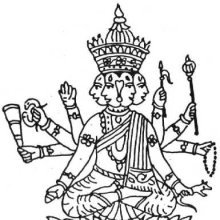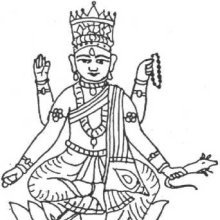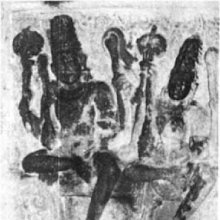Mahakali, Mahākālī, Maha-kali: 17 definitions
Introduction:
Mahakali means something in Buddhism, Pali, Hinduism, Sanskrit, Jainism, Prakrit. If you want to know the exact meaning, history, etymology or English translation of this term then check out the descriptions on this page. Add your comment or reference to a book if you want to contribute to this summary article.
Images (photo gallery)
In Hinduism
Shaktism (Shakta philosophy)
Source: Wisdom Library: ŚāktismMahākālī (महाकाली, “Great Darkness”):—One of the names of Mahākālī (tamas-form of Mahādevī). It represents pure tamas personified. Mahākālī is one of the three primary forms of Devī. Not to be confused with Kālī, she is a more powerful cosmic aspect (vyaṣṭi) of Devi and represents the guṇa (universal energy) named tamas. For reference, see the Devī Māhātmya, a Sanskrit work from the 5th century, incorporated into the Mārkaṇḍeya-Purāṇa.
Source: Red Zambala: The 10 Great Wisdom GoddessesMahā-Kālī is the personification of the universal power of transformation, the transcendent power of Time, the Great Goddess who rules unchallenged over the universe and all that is in it.
All processes in the universe are seen to be cyclic and can be divided in 10 phases connected with the symbolism attached to the mystical number 5 —the five aspects of Śiva and the five aspects of Śakti operate as day and night —the markers of Time.
Mahā-Kālī sub-divides herself into the 10 goddesses known as the Mahāvidyās (ten objects of transcendent wisdom) which are the 10 aspects of the cycle of time — they’re representative of the entire processes of projection and withdrawal of the universe. They are the underlying subtle energies of which the gross universe is the outer expression.
- Kālī,
- Tārā,
- Tripurasundarī,
- Bhuvaneśvarī,
- Chinnamastā,
- Bhairavī,
- Dhūmāvatī,
- Bagalāmukhī,
- Mātaṅgī
- and Kamalā
Mahākālī (महाकाली) is the name of a Mātṛkā-Śakti created by Mahārudra in order to control the plague of demons created by Andhakāsura.—Accordingly, Andhaka-Asura tried to kidnap Umā (Devī Pārvatī), and was fiercely attacked by Mahārudra who shot arrows at him from his mahāpināka. when the arrows pierced the body of Andhakāsura, drops of blood fell to earth and from those drops, thousands of Andhakas arose. To control this plague of demons, Mahārudra created Mātṛkā-Śaktis [viz., Mahākālī] and ordered them to drink the blood of the demons and drain them dry.
Source: Kamakoti Mandali: Nrisimha matrika-mandalaMahākālī (महाकाली) refers to one of the various Mātṛkā-Śaktis created by Rudra in order to destroy the clones that spawned from Andhaka’s body.—Accordingly, [...] Andhakāsura attempted to abduct Girājanandinī (Pārvatī) and thus ensued a fierce battle between Andhakāsura and the great Rudra, the Lord of Umā. Like raktabīja, every drop of blood that fell from the body of Andhaka created another Asura like him and in no time, the entire world was filled with Andhakas. To destroy the growing number of Andhakas, Rudra created innumerable Mātṛkā-Śaktis [viz., Mahākālī]. These Śaktis of immense power at once began to drink every drop of blood that flowed from the body of Andhaka, but they could still not effectively contain the emergence of more and more demons.

Shakta (शाक्त, śākta) or Shaktism (śāktism) represents a tradition of Hinduism where the Goddess (Devi) is revered and worshipped. Shakta literature includes a range of scriptures, including various Agamas and Tantras, although its roots may be traced back to the Vedas.
Purana and Itihasa (epic history)
Source: Wisdom Library: The Matsya-purāṇaMahākālī (महाकाली) is the name of a mind-born ‘divine mother’ (mātṛ), created for the purpose of drinking the blood of the Andhaka demons, according to the Matsya-purāṇa 179.8. The Andhaka demons spawned out of every drop of blood spilled from the original Andhakāsura (Andhaka-demon). According to the Matsya-purāṇa 179.35, “Most terrible they (e.g., Mahākālī) all drank the blood of those Andhakas and become exceedingly satiated.”
The Matsyapurāṇa is categorised as a Mahāpurāṇa, and was originally composed of 20,000 metrical verses, dating from the 1st-millennium BCE. The narrator is Matsya, one of the ten major avatars of Viṣṇu.
Source: archive.org: Shiva Purana - English TranslationMahākālī (महाकाली) was produced from Śiva’s matted locks, according to the Śivapurāṇa 2.2.32. Accordingly, as Brahmā narrated to Nārada:—“[...] then Rudra, the destroyer of the world, plucked out a cluster of his matted hair and struck the top of the mountain with it. [...] the cluster of the matted hair of the lord split into two, on being struck on the mountain, [...] From the other half of the cluster of matted hair Mahākālī was born. O dear one, she was very terrible and was surrounded by crores of goblins [i.e., bhūtas]”.
Note: Mahākālī is represented with a black skin, a hideous or terrible countenance, dripping with snakes, hung round with skulls and human heads, and in all respects resembling a fury rather than a Goddess.
Source: Cologne Digital Sanskrit Dictionaries: The Purana Index1a) Mahākālī (महाकाली).—A Varṇa śakti.*
- * Brahmāṇḍa-purāṇa IV. 44. 57; 32. 4.
1b) A mind-born mother.*
- * Matsya-purāṇa 179. 14; Viṣṇu-purāṇa II. 13. 49.
1c) Came out from the wrath of Śiva.*
- * Vāyu-purāṇa 101. 298.

The Purana (पुराण, purāṇas) refers to Sanskrit literature preserving ancient India’s vast cultural history, including historical legends, religious ceremonies, various arts and sciences. The eighteen mahapuranas total over 400,000 shlokas (metrical couplets) and date to at least several centuries BCE.
General definition (in Hinduism)
Source: WikiPedia: HinduismMahakali (महाकाली, mahākālī), literally translated as “Great Kali”, is the Hindu Goddess of time and death. She is said to represent the ten Mahavidyas or "Great Wisdom (Goddesse)s". She is depicted in this form as having ten heads, ten arms, and ten legs but otherwise usually conforms to the four armed icon in other respects. Each of her ten hands is carrying an implement which varies in different accounts, but each of these represent the power of one of the Devas or Hindu Gods and are often the identifying weapon or ritual item of a given Deva.
In Buddhism
Theravada (major branch of Buddhism)
Source: Pali Kanon: Pali Proper NamesAn eminent Theri of Ceylon. Dpv.xviii.39.
Theravāda is a major branch of Buddhism having the the Pali canon (tipitaka) as their canonical literature, which includes the vinaya-pitaka (monastic rules), the sutta-pitaka (Buddhist sermons) and the abhidhamma-pitaka (philosophy and psychology).
Tibetan Buddhism (Vajrayana or tantric Buddhism)
Source: academia.edu: A Critical Study of the Vajraḍākamahātantrarāja (II)Mahākālī (महाकाली) refers to one the twenty-four Horā (astronomical) Goddess to be invoked during pūjā (ritual offering) in Tantric Buddhism, according to the 9th-century Vajraḍākatantra chapter 18.61-74. [...] A Yogin, putting a vessel in the left side of him, offers various things together with raw flesh, fish, immortal nectar (pañcāmṛta). Then the Yogin invites Goddesses to please them with nectar—five Ḍākinīs and twenty-four Goddesses [viz., Mahākālī] come to the Yogin’s place, forming a maṇḍala.
Source: OSU Press: Cakrasamvara SamadhiMahākālī (महाकाली) is the name of a deity [i.e., oṃ maṃ mahākālāya svāhā; oṃ mahākālyai svāhā], according to the Kalaśa Pūjā [i.e., Kalasha Worship] ritual often performed in combination with the Cakrasaṃvara Samādhi, which refers to the primary pūjā and sādhanā practice of Newah Mahāyāna-Vajrayāna Buddhists in Nepal.

Tibetan Buddhism includes schools such as Nyingma, Kadampa, Kagyu and Gelug. Their primary canon of literature is divided in two broad categories: The Kangyur, which consists of Buddha’s words, and the Tengyur, which includes commentaries from various sources. Esotericism and tantra techniques (vajrayāna) are collected indepently.
Mahayana (major branch of Buddhism)
Source: archive.org: Bulletin of the French School of the Far East (volume 5)Mahākālī (महाकाली) is the name of a Goddess appointed as one of the Divine protector deities of Vārāṇasī (Benares) and Aṅga, according to chapter 17 of the Candragarbha: the 55th section of the Mahāsaṃnipāta-sūtra, a large compilation of Sūtras (texts) in Mahāyāna Buddhism partly available in Sanskrit, Tibetan and Chinese.—In the Candragarbhasūtra, the Bhagavat invites all classes of Gods and Deities to protect the Law [dharma?] and the faithful in their respective kingdoms of Jambudvīpa [e.g., the Goddess Mahākālī in Vārāṇasī and Aṅga], resembling the time of the past Buddhas.

Mahayana (महायान, mahāyāna) is a major branch of Buddhism focusing on the path of a Bodhisattva (spiritual aspirants/ enlightened beings). Extant literature is vast and primarely composed in the Sanskrit language. There are many sūtras of which some of the earliest are the various Prajñāpāramitā sūtras.
In Jainism
General definition (in Jainism)
Source: archive.org: The Jaina Iconography1) Mahākālī (महाकाली) or Puruṣadattā is the name of the Yakṣī (Yakṣiṇī) accompanying Sumatinātha: the fifth of twenty-four Tīrthaṃkaras or Jinas, commonly depicted in Jaina iconography.—[...] Mahākālī of the Śvetāmbaras appears in her representation seated on a lotus with her four hands holding Varoda, noose citrus and goad. Puruṣadattā in her Digambara aspect rides an elephant and holds in her hands a disc, Vajra, fruit and Varada-mudrā. The attributes such as citrus, goad and, noose held by Mahākālī are symbolic of her Yakṣa character. Her other aspect represented by Puruṣadattā makes her half like a Vidyādevī and half like a Yakṣiṇī. Puruṣadattā as Vidyādevī is described as riding a cuckoo and holding a Vajra and lotus. In this case, her symbols of an elephant (Gajendragā), Vajra and citrus are those by which we recognise her as a Yakṣiṇī.
2) Mahākālī (महाकाली) (or Sutārī, Sutārā) is also mentioned as the Yakṣiṇī accompanying Suvidhinātha: the ninth of twenty-four Tīrthaṃkaras or Jinas.—[...] Sutārā Yakṣiṇī of the Śvetāmbaras as described in their books rides a bull and bears four hands with Varada, rosary urn and goad. Mahākālī, the Digambara variant of the Yakṣiṇī sit upon a tortoise and carries in her hands Vajra, club, fruit and Vara-mudrā. The Yakṣiṇī’s toirtoise symbol originates from the same animal as used by Ajitā, her husband. As the names Sutārā or Mahākālī suggest, the Yakṣiṇī’s aspect seems, to some extent, to be Śaivite although Mahākālī has her part to play, as a Vidyādevī, with some common symbolic attributes.
3) Mahākālī (महाकाली) also refers to one of the sixteen Vidyādevīs (goddesses of learning).—The Śvetāmbaras have two descriptions for the goddess [Mahākālī]. According to one, she rides on a man and holds a rosary, fruit,bell and Varada-mudrā. According to another, she equally rides a man but holds a rosary, varja, Abhaya-mudrā and bell. The Digambara form of Mahākālī is to be represented as standing on a corpse and bearing in her hands a bow, sword, fruit and weapon. Though the Yakṣiṇī of the like name the Śvetāmbara one of Sumatinātha and Digambara one of Suvidhinātha, exists in Jain Iconography, the Vidyādevī named Mahākālī partakes more of the nature of Kālī of Brahmanism than of the same Yakṣiṇī.The symbols of sword, bell, rosary, etc,, are sufficiently tantrik in character, the corpse at the feet of the goddess being a true mark of Kālī. The Digambara book states that the goddess grants religious trance (Samādhi) to her worshippers.
4) Mahākālī (महाकाली) is the name of a Yoginī mentioned in various Jaina manuscripts, often being part of a list of sixty-four such deities. How the cult of the Tantrik Yoginīs originated among the vegetarian Jainas is unknown. The Yoginīs (viz., Mahākālī) are known as attendants on Śiva or Pārvatī. But in the case of Jainism, we may suppose, as seen before that they are subordinates to Kṣetrapāla, the chief of the Bhairavas.
Source: archive.org: TrisastisalakapurusacaritraMahākālī (महाकाली) refers to the Yakṣiṇī (i.e., messenger-deity) of Sumati, according to chapter 3.3 [sumatinātha-caritra] of Hemacandra’s 11th century Triṣaṣṭiśalākāpuruṣacaritra: an ancient Sanskrit epic poem narrating the history and legends of sixty-three illustrious persons in Jainism.
Accordingly:—“In his tīrtha appeared the Lord’s messenger-deity, named Tumburu, white bodied, with a Garuḍa for a vehicle, one right hand holding a spear and one in varada-position, holding a mace and a noose in his left hands, always near at hand. likewise appeared Mahākālī, golden, with a lotus for a vehicle, one right hand in varada-position and one holding a noose, holding a citron and a goad in her left hands, the Lord’s messenger-deity, always near”.

Jainism is an Indian religion of Dharma whose doctrine revolves around harmlessness (ahimsa) towards every living being. The two major branches (Digambara and Svetambara) of Jainism stimulate self-control (or, shramana, ‘self-reliance’) and spiritual development through a path of peace for the soul to progess to the ultimate goal.
Languages of India and abroad
Sanskrit dictionary
Source: DDSA: The practical Sanskrit-English dictionaryMahākālī (महाकाली).—an epithet of Durgā in her terrific form.
Mahākālī is a Sanskrit compound consisting of the terms mahā and kālī (काली).
Source: Cologne Digital Sanskrit Dictionaries: Monier-Williams Sanskrit-English Dictionary1) Mahākālī (महाकाली):—[=mahā-kālī] [from mahā-kāla > mahā > mah] f. Name of Durgā in her terrific form, [Mahābhārata; Buddhist literature]
2) [v.s. ...] of one of D°’s attendants, [Horace H. Wilson]
3) [v.s. ...] (with Jainas) of one of the 16 Vidyā-devīs, [Hemacandra]
4) [v.s. ...] of a goddess who executed the commands of the 5th Arhat of the present Avasarpiṇī, [ib.]
Sanskrit, also spelled संस्कृतम् (saṃskṛtam), is an ancient language of India commonly seen as the grandmother of the Indo-European language family (even English!). Closely allied with Prakrit and Pali, Sanskrit is more exhaustive in both grammar and terms and has the most extensive collection of literature in the world, greatly surpassing its sister-languages Greek and Latin.
Kannada-English dictionary
Source: Alar: Kannada-English corpusMahākāli (ಮಹಾಕಾಲಿ):—
1) [noun] the most formidable, terrific form of Pārvati.
2) [noun] one of the sixteen jaina goddess of learning.
--- OR ---
Mahākāḷi (ಮಹಾಕಾಳಿ):—[noun] = ಮಹಾಕಾಲಿ [mahakali].
Kannada is a Dravidian language (as opposed to the Indo-European language family) mainly spoken in the southwestern region of India.
See also (Relevant definitions)
Starts with: Mahakalika, Mahakalikastotra, Mahakalikavaca, Mahakalimata, Mahakalinga, Mahakaliprastararajakavaca, Mahakalisahasranaman, Mahakalishvara, Mahakalisukta, Mahakalitantra, Mahakalivijaya, Mahakaliyantra.
Full-text (+93): Lokapura, Mahakalitantra, Mahakalisukta, Mahakalimata, Makakali, Mahakaliyantra, Mahakala, Makali, Mahakalika, Turiya, Duratyaya, Trishna, Kalaratri, Kali, Nidra, Ekavira, Trisha, Vidya, Sthanu, Trilocana.
Relevant text
Search found 34 books and stories containing Mahakali, Mahākālī, Maha-kali, Mahā-kālī, Mahākāli, Mahākāḷi; (plurals include: Mahakalis, Mahākālīs, kalis, kālīs, Mahākālis, Mahākāḷis). You can also click to the full overview containing English textual excerpts. Below are direct links for the most relevant articles:
Jain Remains of Ancient Bengal (by Shubha Majumder)
The twenty-four Tīrthaṅkaras and their Yakṣas and Yakṣiṇīs < [Chapter 6 - Iconographic Study of Jaina Sculptural Remains]
Cidgaganacandrika (study) (by S. Mahalakshmi)
Verse 164 [Ekādaśa-varṇa] < [Chapter 3 - Third Vimarśa]
Verse 29 [Īśvari leads Siddhā and Sādhaka to Cidākāśa] < [Chapter 2 - Second Vimarśa]
Part 1 - Origin of Tantric system < [Philosophy of Kashmir Tantric System]
The Skanda Purana (by G. V. Tagare)
Chapter 133 - Greatness of Mahākālī < [Section 1 - Prabhāsa-kṣetra-māhātmya]
Chapter 242 - Greatness of Kumārī < [Section 1 - Prabhāsa-kṣetra-māhātmya]
Chapter 18 - Kalakaleśvara (kalakala-īśvara-liṅga) < [Section 2 - Caturaśīti-liṅga-māhātmya]
Jainism in Odisha (Orissa) (by Ashis Ranjan Sahoo)
Jaina Antiquities at Purunagarh (Koraput) < [Chapter 3: Survey of Jaina Antiquities in Odisha]
Iconography of Jain Gods and Goddess < [Chapter 6]
Iconography of Sasanadevis < [Chapter 6]
The Devi Bhagavata Purana (by Swami Vijñanananda)
Chapter 50 - On the Glory of Śakti < [Book 9]
Chapter 11 - On the killing of Madhu Kaiṭabha < [Book 10]
Chapter 2 - On questions put by Śaunaka and other Rsis < [Book 1]
Amaravati Art in the Context of Andhra Archaeology (by Sreyashi Ray chowdhuri)
Lower Kṛṣṇā Valley (11): Gunṭupalli < [Chapter 2 - Amarāvatī and other Archaeological Sites of Ancient Andhra Pradesh]


